Digital Version of ‘Birmingham Quran Manuscript’ Delivered to UAE

It is the first time that this version, which offers the touch sensitivity of a tablet and has become known as the Birmingham Quran, has been seen outside of the UK. Two versions will form permanent centrepieces of next year’s UK-UAE Year of Cultural Collaboration events in Abu Dhabi and Dubai.
To mark the occasion, Sheikh Mohammed bin Zayed, Crown Prince of Abu Dhabi, was given a framed copy of all four pages of the fragment digitally reprinted onto vellum by Prince Charles during a ceremony at Al Jalili Fort in Al Ain.
The four pages – printed on two double-sided fragments – were identified last year by scholars as having been written either during the lifetime of Prophet Muhammad (PBUH) or shortly after his death.
So far, said Professor Sir David Eastwood, vice-chancellor of the English University, the only two copies of the digital version of the text exist outside the university are the ones now in the UAE.
"Because of the special nature of the document and its significance, although we want to share it widely with the world we will do that only in appropriate places and in appropriate ways, so at the moment we don’t intend to produce multiple digital facsimiles," he said.
The original, although available for study by theological scholars, will remain in the care of the University of Birmingham’s Mingana Collection of more than 3,000 Middle Eastern manuscripts. While it will go on public display for a limited time next year in London, "the document of course requires constant appropriate preservation, which is one of the reasons why it won’t be on continuous display", said Prof Eastwood, who was in Al Ain for the launch of the Year of Cultural Collaboration.
The fragment is believed to have found its way to Birmingham in about 1930, among thousands of manuscripts collected on behalf of Edward Cadbury, the philanthropist and heir to the British chocolate company, which forms the basis of the University of Birmingham’s Cadbury Research Library.
But Mingana’s greatest find, which lay hidden among an 18-page fragment of a Quran thought to date from the late 7th century, remained unrecognized for decades.
It was not until in the mid-1990s that a visiting scholar spotted a clue. Sixteen of the pages were written in Kufic script, which had developed around Kufa, south of Baghdad in modern-day Iraq, at the end of the 7th century.
But two others, beautifully penned and still vividly readable, were in Hijazi script, known to have originated in the Arabian Peninsula in the vicinity of Mecca and Medina before the birth of Islam.
It would be another two decades before the final piece of the jigsaw fell into place.
Alba Fedeli, an Islamic studies specialist from Italy, went to Birmingham University to devote her PhD to unravelling the secret. As part of her research, and after careful consideration of the implications for the physical integrity of the document, the university authorized radiocarbon dating.
That took place last year at Oxford University and, accurate to within 95.4 per cent, it dated the parchment to between AD 568 and AD 645.
Source: The National



